engine SKODA FABIA 2003 1.G / 6Y Repair Manual
[x] Cancel search | Manufacturer: SKODA, Model Year: 2003, Model line: FABIA, Model: SKODA FABIA 2003 1.G / 6YPages: 233, PDF Size: 32.04 MB
Page 177 of 233
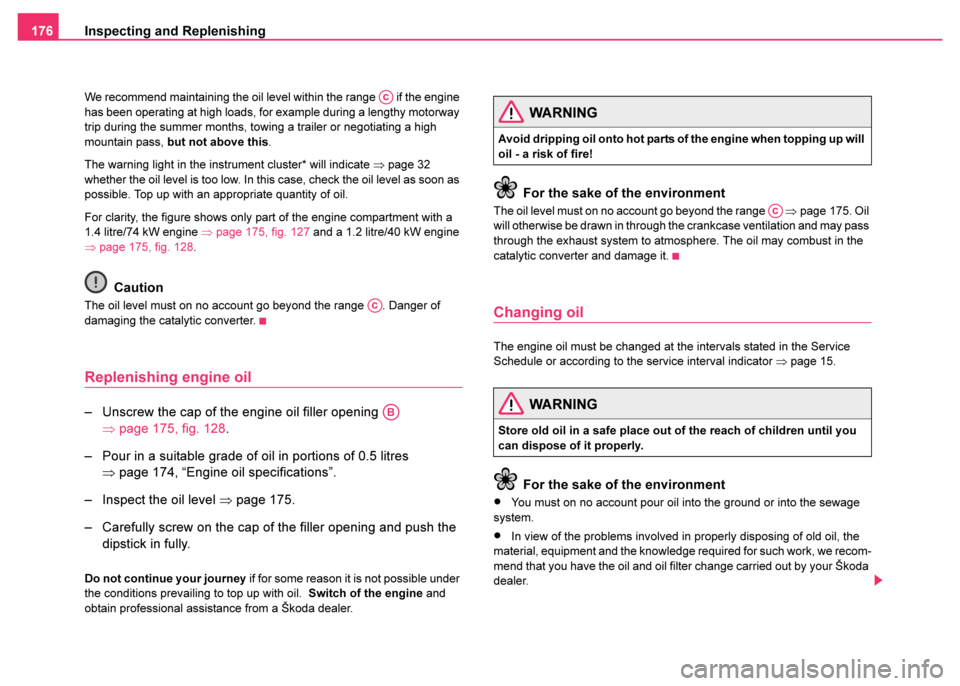
Inspecting and Replenishing
176
We recommend maintaining the oil level within the range if the engine
has been operating at high loads, for example during a lengthy motorway
trip during the summer months, towing a trailer or negotiating a high
mountain pass, but not above this .
The warning light in the instrument cluster* will indicate ⇒page 32
whether the oil level is too low. In this case, check the oil level as soon as
possible. Top up with an appropriate quantity of oil.
For clarity, the figure shows only part of the engine compartment with a
1.4 litre/74 kW engine ⇒page 175, fig. 127 and a 1.2 litre/40 kW engine
⇒ page 175, fig. 128.
Caution
The oil level must on no account go beyond the range . Danger of
damaging the catalytic converter.
Replenishing engine oil
– Unscrew the cap of the engine oil filler opening
⇒page 175, fig. 128 .
– Pour in a suitable grade of oil in portions of 0.5 litres ⇒page 174, “Engine oil specifications”.
– Inspect the oil level ⇒page 175.
– Carefully screw on the cap of the filler opening and push the dipstick in fully.
Do not continue your journey if for some reason it is not possible under
the conditions prevailing to top up with oil. Switch of the engine and
obtain professional assistance from a Škoda dealer.
For the sake of the environment
The oil level must on no account go beyond the range ⇒page 175. Oil
will otherwise be drawn in through the crankcase ventilation and may pass
through the exhaust system to atmosphere. The oil may combust in the
catalytic converter and damage it.
Changing oil
The engine oil must be changed at the intervals stated in the Service
Schedule or according to the service interval indicator ⇒page 15.
For the sake of the environment
•You must on no account pour oil into the ground or into the sewage
system.
•In view of the problems involved in properly disposing of old oil, the
material, equipment and the knowledge required for such work, we recom-
mend that you have the oil and oil filter change carried out by your Škoda
dealer.
Ac
Ac
AB
WARNING
Avoid dripping oil onto hot parts of the engine when topping up will
oil - a risk of fire!
WARNING
Store old oil in a safe place out of the reach of children until you
can dispose of it properly.
Ac
Page 178 of 233

Inspecting and Replenishing177
Using the systemSafetyDriving TipsGeneral MaintenanceBreakdown assist-
anceTechnical DataFabia Praktik
Note
You must not pour any additives into the oil - risk of engine damage!
Cooling system
Coolant
The job of the coolant is to cool the engine.
The cooling system does not require any maintenance under normal oper-
ating conditions. The coolant consists of water with a concentration of
antifreeze agent of 40 %. This mixture not only provides antifreeze protec-
tion down to - 25 °C but also protects the cooling and heating system from
corrosion. It also prevents the formation of scale and significantly
increases the boiling point of the coolant.
You must therefore not reduce the concentration of antifreeze agent in the
coolant by adding water, also not during the summer months or in coun-
tries with a warm climate. The concentration of antifreeze agent in the
coolant must be at least 40%.
You can increase the amount of antifreeze in the coolant iIf a higher
concentration of antifreeze is necessary for climatic reasons but only up
to 60% (antifreeze protection down to approx. -40°C). The antifreeze
protection tails off above that concentration.
Vehicles exported to countries with a cold climate (e.g. Sweden, Norway,
Finland) are already factory-filled with a coolant which offers antifreeze
protection down to about -35°C.
Coolant
The cooling system is factory-filled with TL 774-F (G12 PLUS) coolant,
which is purple in colour. We recommend that you use the same antifreeze agent - G12 PLUS
(purple in colour).
Please contact your Škoda dealer if you have any questions regarding the
coolant or if you wish to fill up with a different coolant.
Your Škoda dealer can also supply you with the correct coolant additives.
Caution
•Other coolant additives may cause operational problems which,
in particular, involves significantly reducing the anticorrosion effect.
•Any faults or problems resulting from corrosion may cause a loss
of coolant and, as a consequence of this, result in major engine
damage.
Inspecting the coolant level
Fig. 129 Engine
compartment: Coolant
expansion bottle
Page 179 of 233
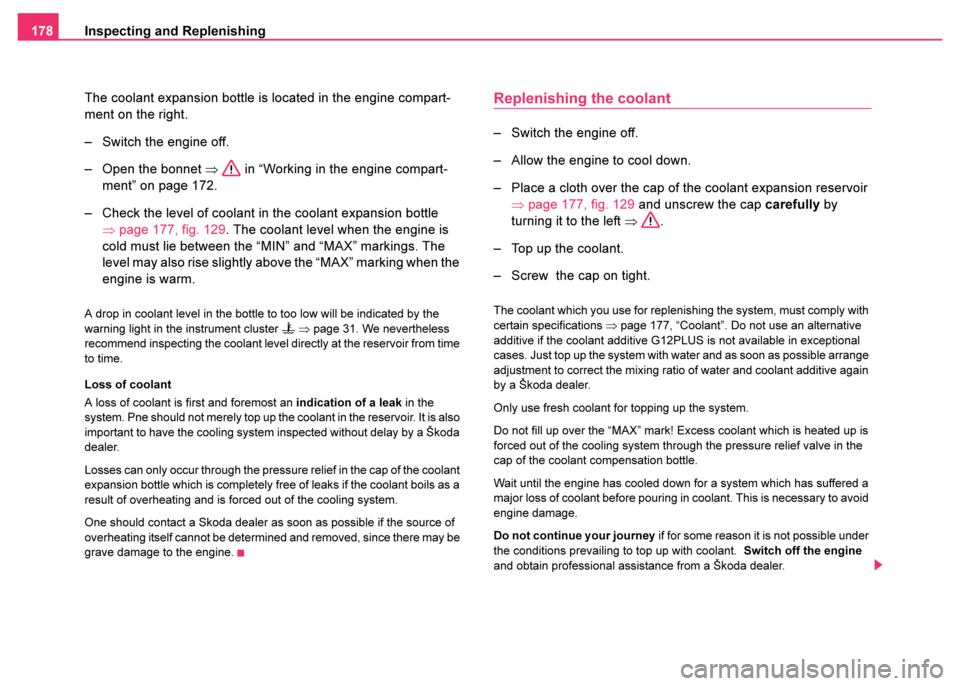
Inspecting and Replenishing
178
The coolant expansion bottle is located in the engine compart-
ment on the right.
– Switch the engine off.
– Open the bonnet ⇒ in “Working in the engine compart-
ment” on page 172.
– Check the level of coolant in the coolant expansion bottle ⇒page 177, fig. 129 . The coolant level when the engine is
cold must lie between the “MIN” and “MAX” markings. The
level may also rise slightly above the “MAX” marking when the
engine is warm.
A drop in coolant level in the bottle to too low will be indicated by the
warning light in the instrument cluster ⇒ page 31. We nevertheless
recommend inspecting the coolant level directly at the reservoir from time
to time.
Loss of coolant
A loss of coolant is first and foremost an indication of a leak in the
system. Pne should not merely top up the coolant in the reservoir. It is also
important to have the cooling system inspected without delay by a Škoda
dealer.
Losses can only occur through the pressure relief in the cap of the coolant
expansion bottle which is completely free of leaks if the coolant boils as a
result of overheating and is forced out of the cooling system.
One should contact a Skoda dealer as soon as possible if the source of
overheating itself cannot be determined and removed, since there may be
grave damage to the engine.
Replenishing the coolant
– Switch the engine off.
– Allow the engine to cool down.
– Place a cloth over the cap of the coolant expansion reservoir ⇒page 177, fig. 129 and unscrew the cap carefully by
turning it to the left ⇒.
– Top up the coolant.
– Screw the cap on tight.
The coolant which you use for replenishing the system, must comply with
certain specifications ⇒page 177, “Coolant”. Do not use an alternative
additive if the coolant additive G12PLUS is not available in exceptional
cases. Just top up the system with water and as soon as possible arrange
adjustment to correct the mixing ratio of water and coolant additive again
by a Škoda dealer.
Only use fresh coolant for topping up the system.
Do not fill up over the “MAX” mark! Excess coolant which is heated up is
forced out of the cooling system through the pressure relief valve in the
cap of the coolant compensation bottle.
Wait until the engine has cooled down for a system which has suffered a
major loss of coolant before pouring in coolant. This is necessary to avoid
engine damage.
Do not continue your journey if for some reason it is not possible under
the conditions prevailing to top up with coolant. Switch off the engine
and obtain professional assistance from a Škoda dealer.
Page 180 of 233
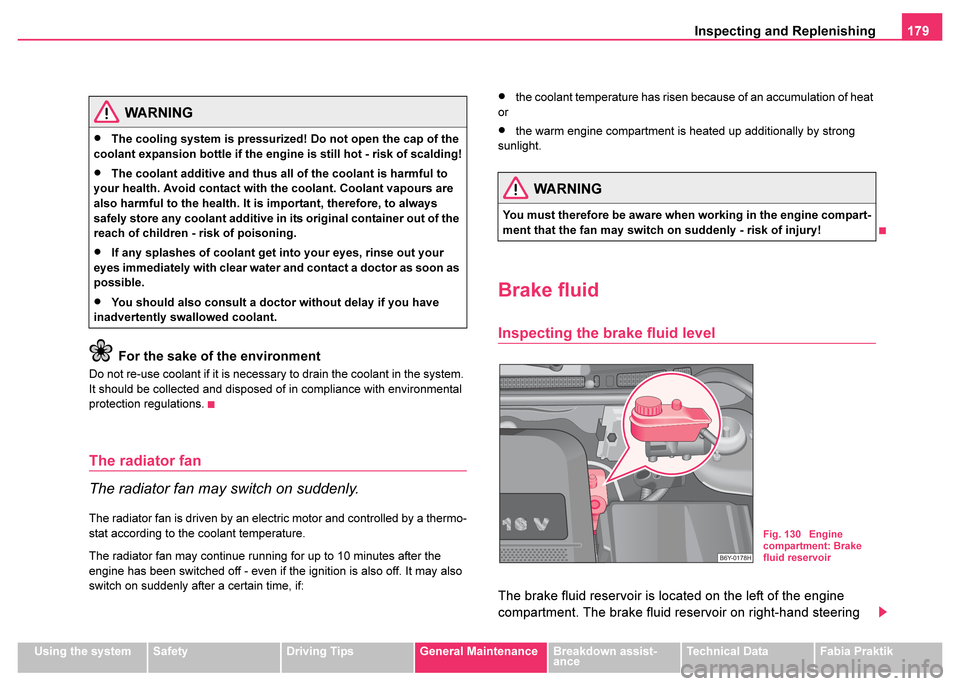
Inspecting and Replenishing179
Using the systemSafetyDriving TipsGeneral MaintenanceBreakdown assist-
anceTechnical DataFabia Praktik
For the sake of the environment
Do not re-use coolant if it is necessary to drain the coolant in the system.
It should be collected and disposed of in compliance with environmental
protection regulations.
The radiator fan
The radiator fan may switch on suddenly.
The radiator fan is driven by an electric motor and controlled by a thermo-
stat according to the coolant temperature.
The radiator fan may continue running for up to 10 minutes after the
engine has been switched off - even if the ignition is also off. It may also
switch on suddenly after a certain time, if:
•the coolant temperature has risen because of an accumulation of heat
or
•the warm engine compartment is heated up additionally by strong
sunlight.
Brake fluid
Inspecting the brake fluid level
The brake fluid reservoir is located on the left of the engine
compartment. The brake fluid reservoir on right-hand steering
WARNING
•The cooling system is pressurized! Do not open the cap of the
coolant expansion bottle if the engine is still hot - risk of scalding!
•The coolant additive and thus all of the coolant is harmful to
your health. Avoid contact with the coolant. Coolant vapours are
also harmful to the health. It is important, therefore, to always
safely store any coolant additive in its original container out of the
reach of children - risk of poisoning.
•If any splashes of coolant get into your eyes, rinse out your
eyes immediately with clear water and contact a doctor as soon as
possible.
•You should also consult a doctor without delay if you have
inadvertently swallowed coolant.
WARNING
You must therefore be aware when working in the engine compart-
ment that the fan may switch on suddenly - risk of injury!
Fig. 130 Engine
compartment: Brake
fluid reservoir
Page 181 of 233
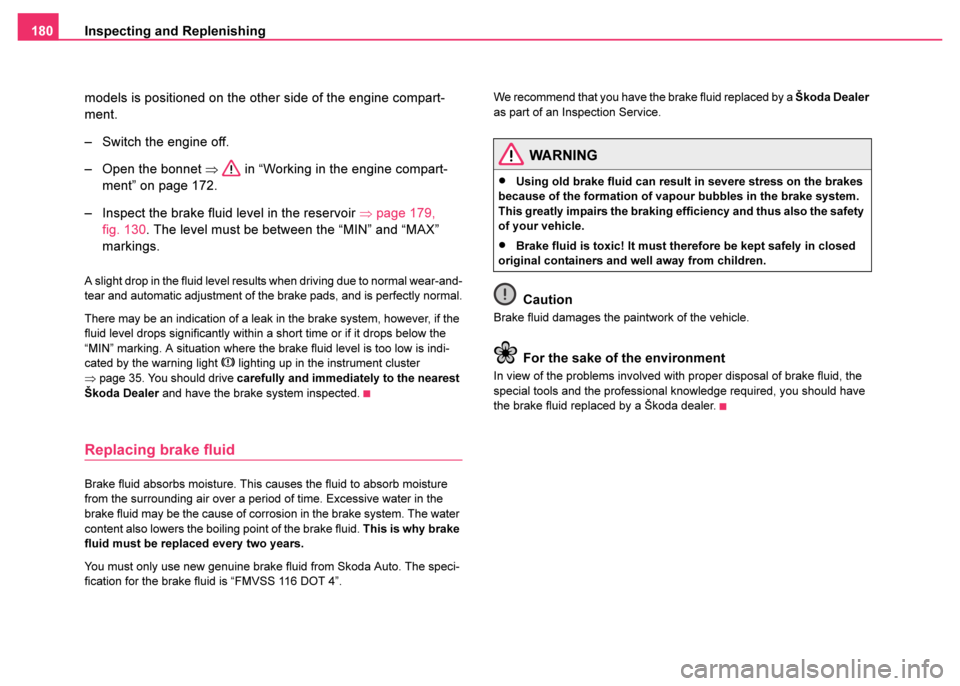
Inspecting and Replenishing
180
models is positioned on the other side of the engine compart-
ment.
– Switch the engine off.
– Open the bonnet ⇒ in “Working in the engine compart-
ment” on page 172.
– Inspect the brake fluid level in the reservoir ⇒page 179,
fig. 130 . The level must be between the “MIN” and “MAX”
markings.
A slight drop in the fluid level results when driving due to normal wear-and-
tear and automatic adjustment of the brake pads, and is perfectly normal.
There may be an indication of a leak in the brake system, however, if the
fluid level drops significantly within a short time or if it drops below the
“MIN” marking. A situation where the brake fluid level is too low is indi-
cated by the warning light
lighting up in the instrument cluster
⇒ page 35. You should drive carefully and immediately to the nearest
Škoda Dealer and have the brake system inspected.
Replacing brake fluid
Brake fluid absorbs moisture. This causes the fluid to absorb moisture
from the surrounding air over a period of time. Excessive water in the
brake fluid may be the cause of corrosion in the brake system. The water
content also lowers the boiling point of the brake fluid. This is why brake
fluid must be replaced every two years.
You must only use new genuine brake fluid from Skoda Auto. The speci-
fication for the brake fluid is “FMVSS 116 DOT 4”. We recommend that you have the brake fluid replaced by a
Škoda Dealer
as part of an Inspection Service.
Caution
Brake fluid damages the paintwork of the vehicle.
For the sake of the environment
In view of the problems involved with proper disposal of brake fluid, the
special tools and the professional knowledge required, you should have
the brake fluid replaced by a Škoda dealer.
WARNING
•Using old brake fluid can result in severe stress on the brakes
because of the formation of vapour bubbles in the brake system.
This greatly impairs the braking efficiency and thus also the safety
of your vehicle.
•Brake fluid is toxic! It must therefore be kept safely in closed
original containers and well away from children.
Page 182 of 233
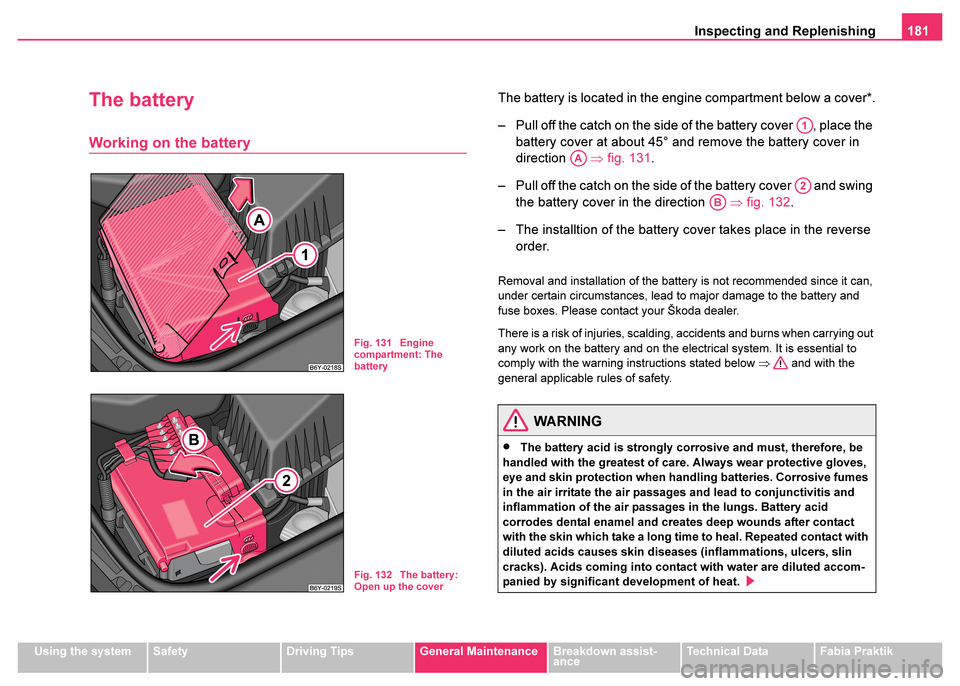
Inspecting and Replenishing181
Using the systemSafetyDriving TipsGeneral MaintenanceBreakdown assist-
anceTechnical DataFabia Praktik
The battery
Working on the battery
The battery is located in the engine compartment below a cover*.
– Pull off the catch on the side of the battery cover , place the
battery cover at about 45° and remove the battery cover in
direction ⇒fig. 131 .
– Pull off the catch on the side of the battery cover and swing the battery cover in the direction ⇒fig. 132 .
– The installtion of the battery cover takes place in the reverse order.
Removal and installation of the battery is not recommended since it can,
under certain circumstances, lead to major damage to the battery and
fuse boxes. Please contact your Škoda dealer.
There is a risk of injuries, scalding, accidents and burns when carrying out
any work on the battery and on the electrical system. It is essential to
comply with the warning instructions stated below ⇒ and with the
general applicable rules of safety.
Fig. 131 Engine
compartment: The
battery
Fig. 132 The battery:
Open up the cover
WARNING
•The battery acid is strongly corrosive and must, therefore, be
handled with the greatest of care. Always wear protective gloves,
eye and skin protection when handling batteries. Corrosive fumes
in the air irritate the air passages and lead to conjunctivitis and
inflammation of the air passages in the lungs. Battery acid
corrodes dental enamel and creates deep wounds after contact
with the skin which take a long time to heal. Repeated contact with
diluted acids causes skin diseases (inflammations, ulcers, slin
cracks). Acids coming into contact with water are diluted accom-
panied by significant development of heat.
A1
AA
A2
AB
Page 185 of 233
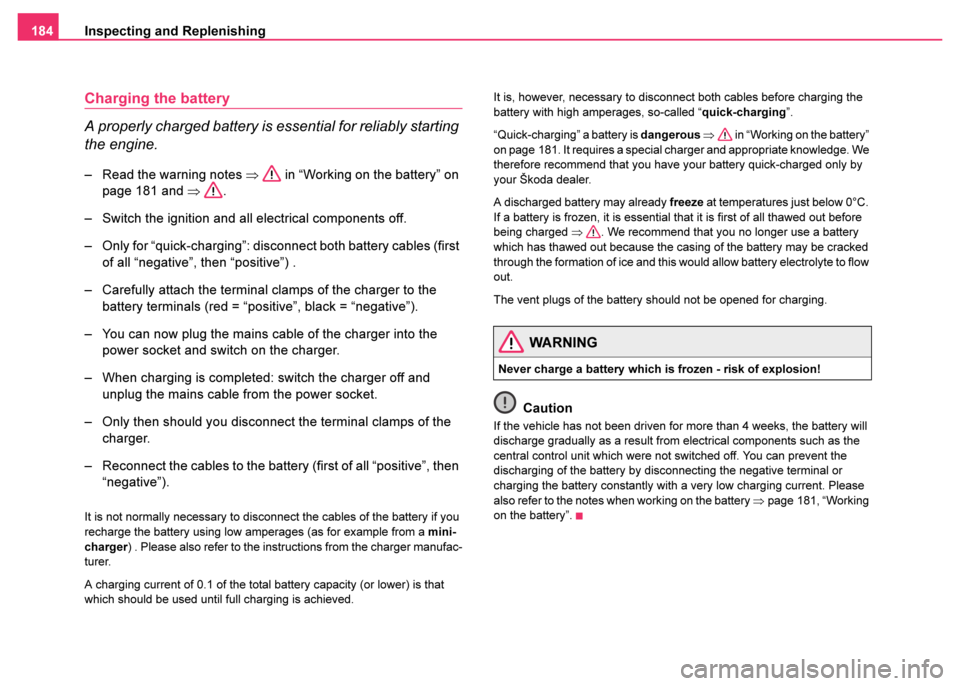
Inspecting and Replenishing
184
Charging the battery
A properly charged battery is essential for reliably starting
the engine.
– Read the warning notes ⇒ in “Working on the battery” on
page 181 and ⇒.
– Switch the ignition and all electrical components off.
– Only for “quick-charging”: disconnect both battery cables (first of all “negative”, then “positive”) .
– Carefully attach the terminal clamps of the charger to the battery terminals (red = “positive”, black = “negative”).
– You can now plug the mains cable of the charger into the power socket and switch on the charger.
– When charging is completed: switch the charger off and unplug the mains cable from the power socket.
– Only then should yo u disconnect the terminal clamps of the
charger.
– Reconnect the cables to the battery (first of all “positive”, then “negative”).
It is not normally necessary to disconnect the cables of the battery if you
recharge the battery using low amperages (as for example from a mini-
charger ) . Please also refer to the instructions from the charger manufac-
turer.
A charging current of 0.1 of the total battery capacity (or lower) is that
which should be used until full charging is achieved. It is, however, necessary to disconnect both cables before charging the
battery with high amperages, so-called “
quick-charging”.
“Quick-charging” a battery is dangerous ⇒ in “Working on the battery”
on page 181. It requires a special charger and appropriate knowledge. We
therefore recommend that you have your battery quick-charged only by
your Škoda dealer.
A discharged battery may already freeze at temperatures just below 0°C.
If a battery is frozen, it is essential that it is first of all thawed out before
being charged ⇒. We recommend that you no longer use a battery
which has thawed out because the casing of the battery may be cracked
through the formation of ice and this would allow battery electrolyte to flow
out.
The vent plugs of the battery should not be opened for charging.
Caution
If the vehicle has not been driven for more than 4 weeks, the battery will
discharge gradually as a result from electrical components such as the
central control unit which were not switched off. You can prevent the
discharging of the battery by disconnecting the negative terminal or
charging the battery constantly with a very low charging current. Please
also refer to the notes when working on the battery ⇒page 181, “Working
on the battery”.
WARNING
Never charge a battery which is frozen - risk of explosion!
Page 186 of 233
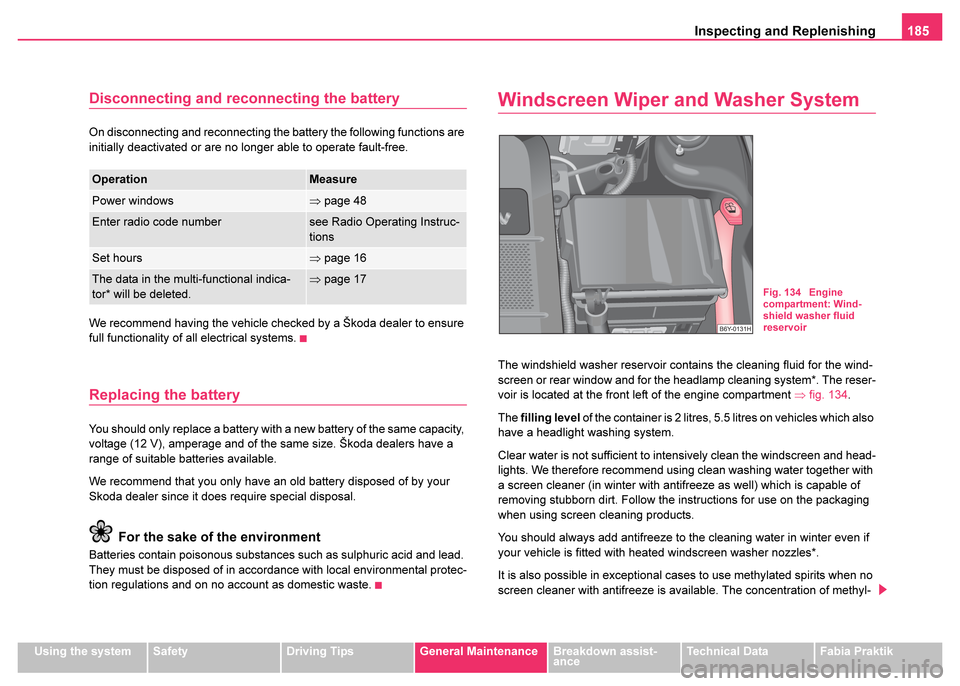
Inspecting and Replenishing185
Using the systemSafetyDriving TipsGeneral MaintenanceBreakdown assist-
anceTechnical DataFabia Praktik
Disconnecting and reconnecting the battery
On disconnecting and reconnecting the battery the following functions are
initially deactivated or are no longer able to operate fault-free.
We recommend having the vehicle checked by a Škoda dealer to ensure
full functionality of all electrical systems.
Replacing the battery
You should only replace a battery with a new battery of the same capacity,
voltage (12 V), amperage and of the same size. Škoda dealers have a
range of suitable batteries available.
We recommend that you only have an old battery disposed of by your
Skoda dealer since it does require special disposal.
For the sake of the environment
Batteries contain poisonous substances such as sulphuric acid and lead.
They must be disposed of in accordance with local environmental protec-
tion regulations and on no account as domestic waste.
Windscreen Wiper and Washer System
The windshield washer reservoir contains the cleaning fluid for the wind-
screen or rear window and for the headlamp cleaning system*. The reser-
voir is located at the front left of the engine compartment ⇒fig. 134.
The filling level of the container is 2 litres, 5.5 litres on vehicles which also
have a headlight washing system.
Clear water is not sufficient to intensively clean the windscreen and head-
lights. We therefore recommend using clean washing water together with
a screen cleaner (in winter with antifreeze as well) which is capable of
removing stubborn dirt. Follow the instructions for use on the packaging
when using screen cleaning products.
You should always add antifreeze to the cleaning water in winter even if
your vehicle is fitted with heated windscreen washer nozzles*.
It is also possible in exceptional cases to use methylated spirits when no
screen cleaner with antifreeze is available. The concentration of methyl-
OperationMeasure
Power windows⇒ page 48
Enter radio code numbersee Radio Operating Instruc-
tions
Set hours⇒page 16
The data in the multi-functional indica-
tor* will be deleted.⇒page 17Fig. 134 Engine
compartment: Wind-
shield washer fluid
reservoir
Page 187 of 233

Inspecting and Replenishing
186
ated spirits must not be more than 15 %. Please note, however, that the
antifreeze protection at this concentration is only adequate down to -5°C.
Caution
•On no account should you add radiator antifreeze or other additives to
the windscreen washer fluid.
•If the vehicle is fitted with headlight cleaning system, you should only
add cleaning products which do not attack the polycarbonate coating of
the headlights to the windscreen washer fluid. Please contact a Škoda
dealer, he will tell you, which cleaning product you can use.
Note
Do not take the filter out of the windscreen wash container when filling it
up again with liquid otherwise dirt can get into the liquid transportation
system and can lead to faults in operation of the windscreen wash
system.
Spark plugs
The spark plugs will also be checked as part of the Inspection Service.
Please observe the following if spark plugs have to be renewed inbetween
inspection services.
•Spark plugs and the ignition system are matched to the engine and
therefore contribute to lower emissions in the exhaust gases.
•Only use the spark plugs foreseen for the engine concerned if you wish
to avoid operational faults, engine damage and loss of approval and
licensing of the vehicle due to false exhaust gas values or unshielded
spark plugs. Particularly important parameters include the number of elec- trodes, the thermal value and possibly also the radio frequency suppres-
sion level.
Spark plugs are constantly being further developed. It is therefore advis-
able to just obtain spark plugs from Skoda dealers since they are informed
about latest developments.
V-ribbed belts
The V-ribbed is one of the most highly loaded components on a vehicle.
This is why there are high demands on quality made on the V-ribbed belt.
It not sufficient when replacing the V-ribbed belt to choose just any one of
the same size.
One should only use the V-ribbed belt foreseen for use
on that vehicle for safety reason.
V-ribbed belts are constantly being further developed. It is therefore advis-
able to just obtain them from Skoda dealers since they are informed about
latest developments.
The dust and pollen filter*
The dust and pollen filter for the heating and ventilation system is located
in the heater. The filter is replaced according to directions given in the
Service Plan. The filter should be replaced even earlier when the air flow
is reduced significantly.
Changing of the filter is undertaken by a Skoda dealer as part of the
inspection service.
Page 193 of 233
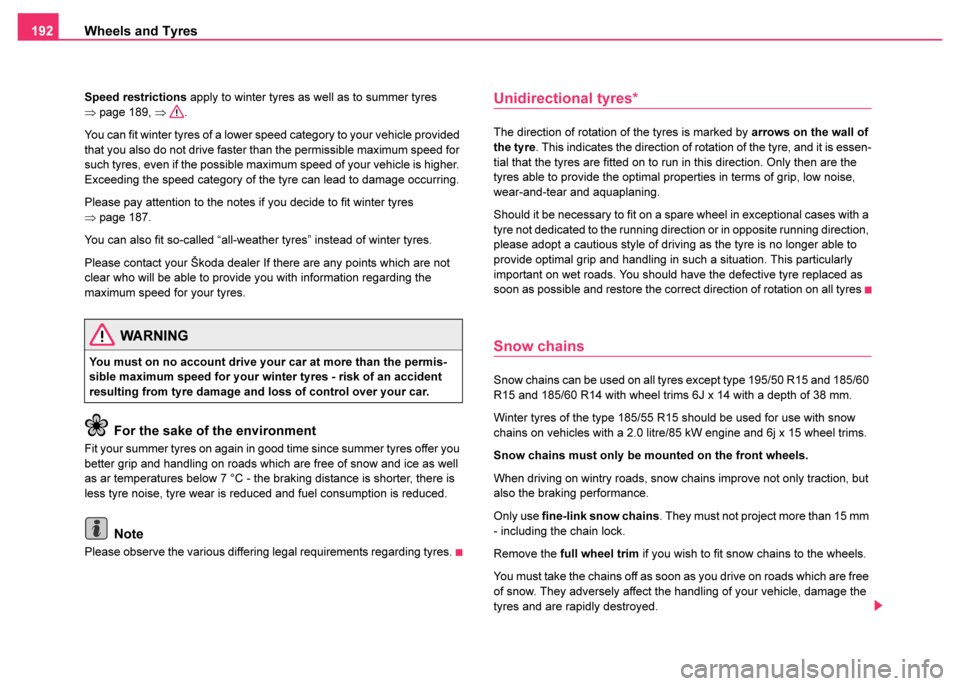
Wheels and Tyres
192
Speed restrictions apply to winter tyres as well as to summer tyres
⇒ page 189, ⇒.
You can fit winter tyres of a lower speed category to your vehicle provided
that you also do not drive faster than the permissible maximum speed for
such tyres, even if the possible maximum speed of your vehicle is higher.
Exceeding the speed category of the tyre can lead to damage occurring.
Please pay attention to the notes if you decide to fit winter tyres
⇒ page 187.
You can also fit so-called “all-weather tyres” instead of winter tyres.
Please contact your Škoda dealer If there are any points which are not
clear who will be able to provide you with information regarding the
maximum speed for your tyres.
For the sake of the environment
Fit your summer tyres on again in good time since summer tyres offer you
better grip and handling on roads which are free of snow and ice as well
as ar temperatures below 7 °C - the braking distance is shorter, there is
less tyre noise, tyre wear is reduced and fuel consumption is reduced.
Note
Please observe the various differing legal requirements regarding tyres.
Unidirectional tyres*
The direction of rotation of the tyres is marked by arrows on the wall of
the tyre . This indicates the direction of rotation of the tyre, and it is essen-
tial that the tyres are fitted on to run in this direction. Only then are the
tyres able to provide the optimal properties in terms of grip, low noise,
wear-and-tear and aquaplaning.
Should it be necessary to fit on a spare wheel in exceptional cases with a
tyre not dedicated to the running direction or in opposite running direction,
please adopt a cautious style of driving as the tyre is no longer able to
provide optimal grip and handling in such a situation. This particularly
important on wet roads. You should have the defective tyre replaced as
soon as possible and restore the correct direction of rotation on all tyres
Snow chains
Snow chains can be used on all tyres except type 195/50 R15 and 185/60
R15 and 185/60 R14 with wheel trims 6J x 14 with a depth of 38 mm.
Winter tyres of the type 185/55 R15 should be used for use with snow
chains on vehicles with a 2.0 litre/85 kW engine and 6j x 15 wheel trims.
Snow chains must only be mounted on the front wheels.
When driving on wintry roads, snow chains improve not only traction, but
also the braking performance.
Only use fine-link snow chains . They must not project more than 15 mm
- including the chain lock.
Remove the full wheel trim if you wish to fit snow chains to the wheels.
You must take the chains off as soon as you drive on roads which are free
of snow. They adversely affect the handling of your vehicle, damage the
tyres and are rapidly destroyed.
WARNING
You must on no account drive your car at more than the permis-
sible maximum speed for your winter tyres - risk of an accident
resulting from tyre damage and loss of control over your car.